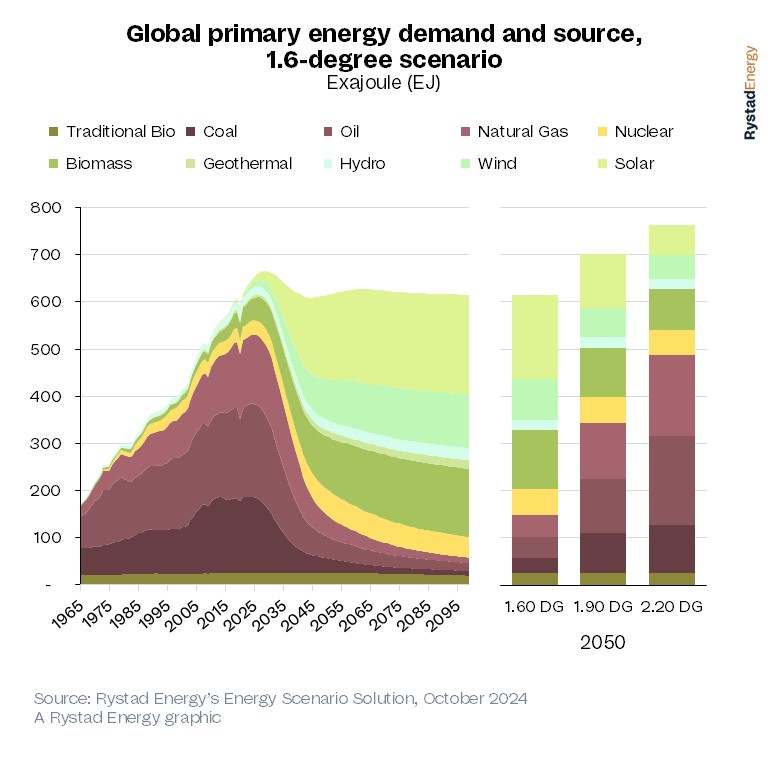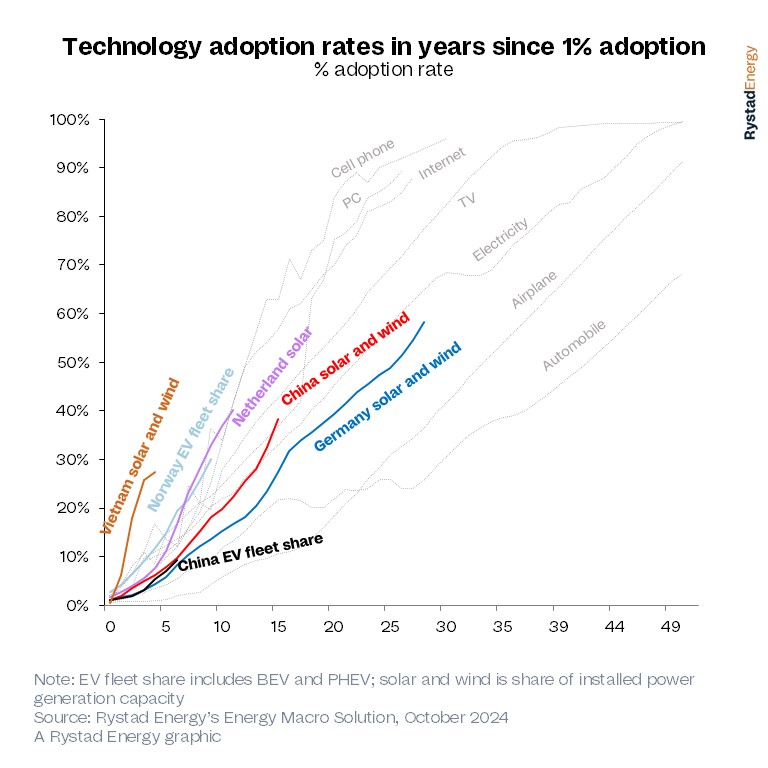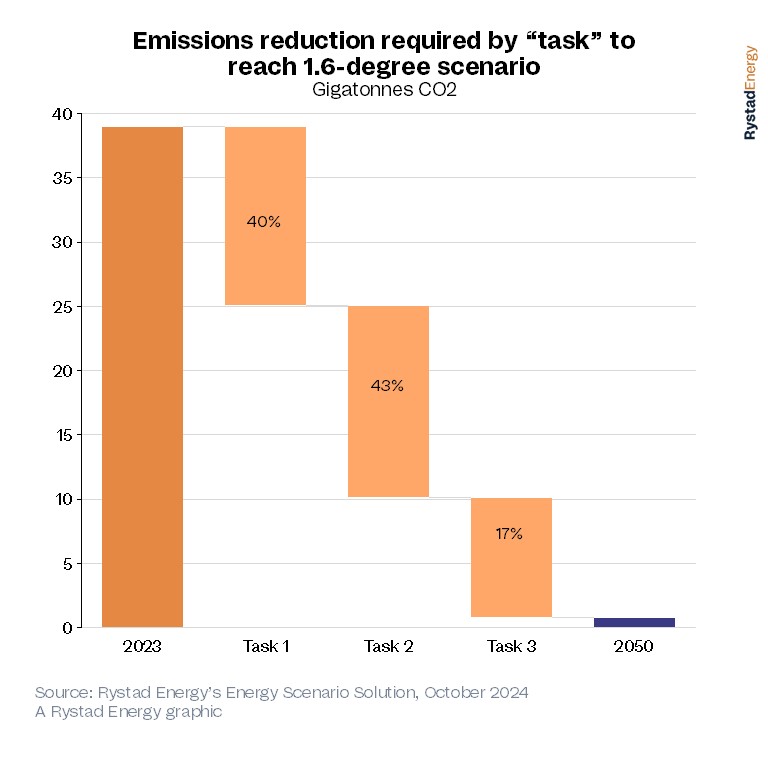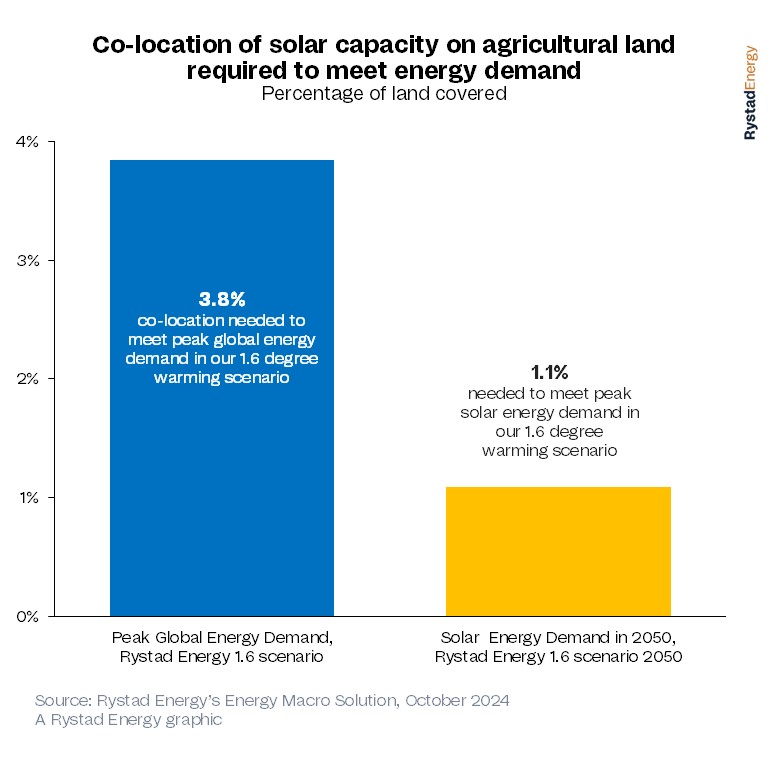Rystad Energy’s 2024 Report: Global Energy Transformation Gains Momentum
October 31, 2024
- The global energy transition is accelerating, driven by rapid advancements in renewable energy technologies and increasing investments.
- Achieving the ambitious goal of limiting global warming to 1.6 degrees Celsius requires a three-pronged approach: expanding renewable energy sources, electrifying various sectors, and tackling residual emissions from hard-to-abate industries.
- The transition to a cleaner energy system promises not only environmental benefits but also greater energy efficiency and cost-effectiveness.

The energy transition is gaining momentum, and the industry is accelerating toward a widespread, fundamental global evolution. Rystad Energy is proud to release its flagship annual report – Global Energy Scenarios 2024 – which concludes that the goal of limiting global warming to 1.6 degrees Celsius above pre-industrial levels is a monumental task, but still achievable.
The global energy system is set for transformational change in the coming decades. Solar, wind and battery costs are continuing to drop at unprecedented speed, and capacity is coming online at record pace, with solar installations surging 60% to 360 gigawatt-hours alternating current (GWac) in 2023. Electric vehicles (EVs) are expected to reach 23% of new passenger car sales this year, compared with 3% only four years ago, while annual investments in new renewable energy infrastructure exceeded oil and gas spending for the first time in 2023.
The unprecedented transformation of the global energy landscape requires three clear steps:
- Clean up and grow the power sector, mainly by rapidly expanding solar, wind and battery storage capacity
- Electrify almost everything that can be electrified
- Tackle residual emissions from hard-to-abate sectors like heavy industry, aviation, steel and cement
The global energy transition is no longer a distant goal – it has been ongoing for years, and we are now in the acceleration phase. As solar, batteries and EVs continue to surge past key tipping points, the global energy system’s transition will eventually reach a sustainable cruising speed. Then, the industry’s focus will shift to maintaining the pace toward a cleaner, more resilient energy future.
Jarand Rystad, CEO and Founder, Rystad Energy

Download your copy of Global Energy Scenarios 2024.
Limiting global warming to 1.6 degrees requires a rapid acceleration of the energy transition, so this is not the only possible future for the global energy system. In the new report, we look at three main global warming possibilities; scenarios that result in1.6, 1.9 or 2.2 degrees Celsius of global warming. Rystad Energy research and analysis shows that if global warming is to hit 2.2 degrees, the current pace of cleantech deployment would need to slow significantly, and the global urgency behind decarbonization would have to cool down. To realize the 1.9-degree scenario, which is most closely aligned with our bottom-up analysis of the current short-term pathway, recent progress should continue on a similar trajectory. However, for the 1.6-degree scenario to become reality, we must see technological developments follow a steep S-curve.
The report dives into cleantech adoption rates and examines how quickly renewable energy is being deployed, comparing its adoption to other disruptive technologies like automobiles, the internet, and cell phones. The numbers show that solar, wind and EV acceptance in some countries is outpacing previous disruptive technologies by a significant margin.

Today, renewables are already responsible for more than one-third of global electricity production. To meet the demand in our 1.6-degree scenario, solar and wind power will need to grow to 44% of the primary energy supply by 2050. This is a much larger share of total supply than what is needed in the 1.9-degree scenario, which would necessitate 25% supply from these sources. However, solar, wind, EV and battery supply chains have expanded at a rapid pace, proving that they may deliver on the 1.6-degree requirement, and many now outcompete even fossil-fuel alternatives on pure economics without subsidies. For instance, the supply chain for solar modules will reach an annual capacity of about 1.65 terawatts direct current (TWdc) by the end of 2024, a 63% increase in just one year. This economic advantage will only grow as capacity expands and supply becomes cheaper.
Reaching the goals of the Paris Agreement requires deep decarbonization across all sectors of the economy and a broad range of technologies. While the road ahead could seem complex, the report outlines the three aforementioned tasks essential for reaching net zero: clean up and grow the power sector, electrify almost everything, and tackle the residual emissions.

Renewables are the main tool used to address task one. Electricity generation alone contributed 15 gigatonnes of carbon dioxide (Gt CO2) emissions in 2023, 39% of annual global emissions. This requires a rapid expansion of operational solar and wind capacity and supply chain capabilities, and the phase-out of coal-fired power plants.
The second task is to electrify almost everything, including the transportation, industry and building segments, which are currently heavily reliant on fossil fuels. Maxing out economically viable electrification potential in these sectors would result in 43% of the total required emission abatement to reach the 1.6-degree scenario.
The third task is to clean up residual emissions – in other words emissions that cannot be eliminated through electrification. This requires the development and deployment of new technologies, such as carbon capture, utilization and storage (CCUS), direct air carbon capture (DACC), hydrogen-based alternative fuels, and biofuels. However, many of these technologies are still in the early stages of development, and significant technical, economic and regulatory progress must be made to de-risk project investments.
Task three benefits from a domino effect of tasks one and two – as greater energy efficiency will naturally reduce the residual emissions from fossil fuels. The future global energy system will not only be cleaner but also more efficient, delivering cheaper and more “useful energy” with minimal losses compared to traditional fossil fuels. Currently, nearly half of all primary energy is lost through emissions, transport, or production inefficiencies. For example, coal-fired power wastes 60% of its energy potential, while gas-for-power loses 50%. In contrast, EVs are 70% more energy-efficient than diesel cars when in use.
While the three core tasks hold the potential to unlock the 1.6-degree scenario, realizing an even lower global warming scenario is extremely challenging. However, a couple of upsides exist that could take emission reductions to another level. Accelerated methane reductions is one such upside, given methane’s high short-term potency as a greenhouse gas. Technologies like precision fermentation in agriculture are becoming highly competitive and can achieve up to 97% less methane emissions than traditional animal agriculture, while using only 10% of the land and 4% of the water, offering a dramatic pathway to cut emissions.
Another upside is a more effective use of land, which enables a faster rollout of renewables. For instance, the co-location of solar on farmland through agrivoltaics could meet the highest energy demand under a 1.6-degree scenario by using just 3.8% of agricultural land. Combined, these strategies offer a promising route to meeting more ambitious climate targets, especially with supportive policies to unlock their potential.

More Top Reads From Oilprice.com
<!–
Trending Discussions
–>

Rystad Energy
Rystad Energy is an independent energy consulting services and business intelligence provider offering global databases, strategic advisory and research products for energy companies and suppliers,…
Search
RECENT PRESS RELEASES
Related Post






